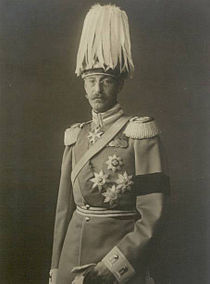Mindaugas II
From Kaiserreich
|
Mindaugas II of Lithuania (otherwise known as William Charles Florestan Gero Crescentius, 2nd Duke of Urach and Count of Wurttemberg, May 30 1864 - March 24 1928, Vilnus) was the previous King of Lithuania. He was elected on July 11, 1918 and crowned in January 1920. He died in 1928.
Contents |
Early life
Born as HSH Prince Wilhelm Karl Florestan Gero Crescentius of Urach, Count of Württemberg, he was the elder son of Wilhelm, 1st Duke of Urach (the head of a morganatic branch of the Royal House of Württemberg), and his second wife, Princess Florestine of Monaco, occasional acting Regent of Monaco (daughter of Prince Florestan I of Monaco). At the age of four Wilhelm succeeded his father as Duke of Urach. He spent much of his childhood in Monaco, where his mother Florestine often managed the government while her nephew, Prince Albert I of Monaco, went on long oceanographic explorations. Wilhelm was culturally francophone.
Candidate for various thrones
Through his mother, Wilhelm was the legitimate heir to the throne of Monaco. Wilhelm's cousin Prince Albert I of Monaco had only one son Louis who was unmarried and had no legitimate children. The French Republic, however, was reluctant to see a German prince ruling Monaco. Under French pressure Monaco passed a law in 1911 recognising Louis's illegitimate daughter, Charlotte, as heir; she was adopted in 1918 by her grandfather Prince Albert I.
In 1913 Wilhelm was one of several princes considered for the throne of Albania; he was supported by Catholic groups in the north. In 1914 Prince William of Wied was selected instead. In 1917, as a newly-retired general Wilhelm sounded out the possibility of being made Duke of Lorraine after the war was over.
Military career
Typical of his family, Wilhelm entered the Württemberg army in the 1890s and was a professional general by the outbreak of the Weltkrieg in 1914, commanding the 26th Infantry Division. Until November 1914 they were part of the German assault on France. In December 1914 the division fought in the battle to cross the Bzura river in Poland. From June to September 1915 the division moved from north of Warsaw to positions close to the Neman River, an advance of hundreds of miles in the campaign in which Poland was taken. In October-November 1915 it took part in the assault on Serbia, moving from west of Belgrade to Kraljevo in less than a month. At Ypres in Belgium from December 1915 to July 1916, the division was largely destroyed in the Somme battles from August to November 1916, holding the Schwaben Redoubt (Württemberg is part of Swabia). Wilhelm retired as a general on January 5, 1917.
King of Lithuania
William of Urach descended from the Lithuanian Jagiellon dynasty, among others kings Casimir IV of Poland, Vladislas Jagello I of Poland and Vladislaus II of Bohemia and Hungary, as well as Lithuanian monarchs Algirdas and Gediminas, and several medieval princes of Polock, Vitebsk and Smolensk.
On June 4, 1918 the Council of Lithuania voted to invite Wilhelm to become the king of a newly independent Lithuania. Wilhelm agreed and was elected on July 11, 1918, taking the name Mindaugas II. His election can be explained by several factors:
- he was Roman Catholic (the dominant religion in Lithuania)
- he was not a member of the House of Hohenzollern, the family to which belonged the Kaiser Wilhelm II who wanted Lithuania to be a monarchy in personal union with Prussia
- he had had a successful military career
- if the Central Powers had won the war, Lithuania could have expected German protection in the event of future intrusions by Russia.
According to Wilhelm's agreement with the Council of Lithuania he had to live in Lithuania and speak its language.
From the beginning Wilhelm's reign was controversial. Four of the twenty members of the Council of Lithuania left in protest. Germany recognized him as King, but none of the Entente powers did. After Germany's advance in the Western (and by then, the only) front and the seemingly imminent German victory, Wilhelm was crowned in a grand ceremony in Vilnus in 1920.
Mindaugas' rule was quite short, only 8 years as crowned King. In this time, he faced the many problems that a newborn nation had. His rule saw Lithuania join German-led Mitteleuropa and forming close ties with other members of the alliance, especially the United Baltic Duchy in the north. He died on March 24 1928 and was succeeded his son Karl Gero, who was crowned as King Mindaugas III.

